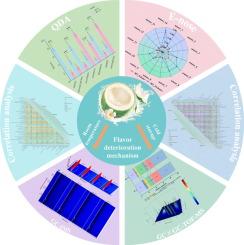定量描述分析、电子鼻、GC- ims、GC × GC- tof - ms评价椰子水风味变质的综合分析方法
IF 8
1区 农林科学
Q1 FOOD SCIENCE & TECHNOLOGY
引用次数: 0
摘要
椰子汁质量的恶化往往会导致风味的显著变化。本研究拟结合定量描述分析(QDA)、电子鼻分析(E-nose)、GC- ims和GC × GC- tof - ms等多种分析方法,探讨不同深度贮藏温度下椰子水风味变质的机理。结果表明,在贮藏过程中,椰子水的甜度、酸味和鲜味变化最为显著。挥发性成分分析表明,GC × GC- tof - ms和GC- ims相结合可以更全面地反映椰子水在贮藏过程中的风味变化,结果表明,椰子水在贮藏过程中酯类、醛类和酮类发生了显著变化。(E, E)-2,4-七烯二醛是椰子汁贮存过程中亚油酸和亚麻酸的降解产物,是一种差异挥发性化合物。相对气味活性值(ROAV)分析结果表明,椰子水的风味变化主要与醛类和酮类有关。2-十一烷酮和(E)-2-壬烯醛是两种储存温度下导致椰子水风味变质的挥发性化合物,而(E)-2-壬烯醛是亚油酸氧化产生的二级降解物质。综上所述,可以发现椰子水的风味变质主要与脂质氧化有关,阐明了脂质氧化在风味变化中的关键作用,为后续植物性饮料风味变化的研究提供了新的方向。本文章由计算机程序翻译,如有差异,请以英文原文为准。

A multi-analytical approach for flavor deterioration assessment of coconut water using quantitative descriptive analysis, E-nose, GC-IMS, and GC × GC-TOF-MS
Quality deterioration of coconut water often leads to a significant change in flavor. This study intends to reveal the mechanism of flavor deterioration of coconut water under different storage temperatures in depth by combining various analytical methods including quantitative descriptive analysis (QDA), E-nose, GC-IMS and GC × GC-TOF-MS. The results showed that sweetness, sourness and umami of coconut water changed most significantly during the storage. The analysis of volatile compounds showed that the combination of GC × GC-TOF-MS and GC-IMS can provide a more comprehensive result of flavor changes during the storage of coconut water, and the results revealed that esters, aldehydes, and ketones changed significantly during the storage of coconut water. (E, E)-2,4-Heptadienal was screened as a differential volatile compound in coconut water during the storage, which is a degradation product of linoleic acid and linolenic acid. The results of relative odor activity value (ROAV) analysis indicated that the flavor changes in coconut water were mainly related to aldehydes and ketones. 2-Undecanone and (E)-2-nonenal were the volatile compounds that contributed significantly to the flavor deterioration of coconut water at both storage temperatures, and (E)-2-nonenal is a secondary degradation substance produced by the oxidation of linoleic acid. In summary, it can be found that the flavor deterioration of coconut water is mainly related to lipid oxidation, which clarifies the critical role of lipid oxidation in flavor changes and provides a new direction for the subsequent study of flavor changes in plant-based beverages.
求助全文
通过发布文献求助,成功后即可免费获取论文全文。
去求助
来源期刊

Food Research International
工程技术-食品科技
CiteScore
12.50
自引率
7.40%
发文量
1183
审稿时长
79 days
期刊介绍:
Food Research International serves as a rapid dissemination platform for significant and impactful research in food science, technology, engineering, and nutrition. The journal focuses on publishing novel, high-quality, and high-impact review papers, original research papers, and letters to the editors across various disciplines in the science and technology of food. Additionally, it follows a policy of publishing special issues on topical and emergent subjects in food research or related areas. Selected, peer-reviewed papers from scientific meetings, workshops, and conferences on the science, technology, and engineering of foods are also featured in special issues.
 求助内容:
求助内容: 应助结果提醒方式:
应助结果提醒方式:


